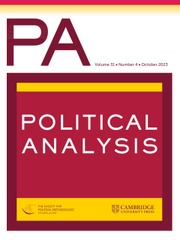Article contents
Using Auxiliary Data to Estimate Selection Bias Models, with an Application to Interest Group Use of the Direct Initiative Process
Published online by Cambridge University Press: 04 January 2017
Abstract
Recent work in survey research has made progress in estimating models involving selection bias in a particularly difficult circumstance—all nonrespondents are unit nonresponders, meaning that no data are available for them. These models are reasonably successful in circumstances where the dependent variable of interest is continuous, but they are less practical empirically when it is latent and only discrete outcomes or choices are observed. I develop a method in this article to estimate these models that is much more practical in terms of estimation. The model uses a small amount of auxiliary information to estimate the selection equation parameters, which are then held fixed while estimating the equation of interest parameters in a maximum-likelihood setting. After presenting Monte Carlo analyses to support the model, I apply the technique to a substantive problem: Which interest groups are likely to to be involved in support of potential initiatives to achieve their policy goals?
- Type
- Research Article
- Information
- Copyright
- Copyright © Political Methodology Section of the American Political Science Association 2003
References
- 7
- Cited by


